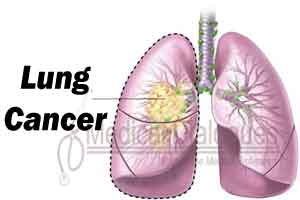- Home
- Editorial
- News
- Practice Guidelines
- Anesthesiology Guidelines
- Cancer Guidelines
- Cardiac Sciences Guidelines
- Critical Care Guidelines
- Dentistry Guidelines
- Dermatology Guidelines
- Diabetes and Endo Guidelines
- Diagnostics Guidelines
- ENT Guidelines
- Featured Practice Guidelines
- Gastroenterology Guidelines
- Geriatrics Guidelines
- Medicine Guidelines
- Nephrology Guidelines
- Neurosciences Guidelines
- Obs and Gynae Guidelines
- Ophthalmology Guidelines
- Orthopaedics Guidelines
- Paediatrics Guidelines
- Psychiatry Guidelines
- Pulmonology Guidelines
- Radiology Guidelines
- Surgery Guidelines
- Urology Guidelines
Adaptive radiotherapy reduces pneumonitis while controlling lung cancer

Vienna : Lung cancer patients who are treated with radiotherapy can develop an inflammation of the lung tissue called pneumonitis; this can limit the dose of radiation they can receive and severe forms of pneumonitis, if left untreated, can be fatal.
Now researchers have found that it is possible to adapt radiation treatment so that it targets the tumour much more precisely. "This has resulted in a significant decrease in the incidence of radiation pneumonitis in patients with advanced lung cancer, while still slowing and controlling the growth of the cancer," Dr Azza Khalil, a clinical oncologist at Aarhus University Hospital, Denmark, told the ESTRO 36 conference.
"Previously, the radiation therapist would set up the patient on the radiotherapy machines using the bone structures in the chest and skin tattoos to mark the area to be treated. We have already shown that during the course of radiotherapy the anatomical structure can differ and the cancer change position inside the chest," explained Dr Khalil. "For this study the radiation therapists used a daily 3D image of the tumour to adjust the patient's position under the radiotherapy machine, and if they discovered any change during the course of radiotherapy, doctors and physicists were able to adapt the radiation treatment. This meant they could target the tumour area more accurately, leaving smaller margins so that less healthy tissue was irradiated."
Dr Khalil and her colleagues analysed data from 108 patients with locally advanced lung cancer (cancer that had started to spread from where it started to nearby tissue or lymph nodes) who had received adaptive radiation treatment (ART) with smaller margins after April 2013. They matched them with a control group of 102 patients who had been treated prior to April 2013 without the adaptive strategy, using the older method for planning the treatment, which involved leaving larger margins. They followed the patients for a median average of 20 months (ranging from two to 56 months).
"We found that the incidence of radiation pneumonitis that was serious enough to require treatment (grade 2 and above) decreased significantly from 50% of patients in the group treated without adaptive radiation treatment to 33% in the group that did receive adaptive radiation treatment," said Dr Khalil. "However, there was no difference between the two groups in the rates of recurrence of cancer or the failure of the radiotherapy to control tumour growth."
Thirty-two percent of patients treated with ART had a recurrence of cancer at the site of the original tumour compared to 36% of patients in the non-ART group. Failure to control tumour growth (loco-regional failure) occurred in 45% of the ART group and 48% of the non-ART group.
The researchers have not followed the patients for long enough to assess the rates of overall survival between the two groups. However, the average amount of time that patients lived without their disease progressing was similar between the two groups: 16 months for the ART group and 19 months for the non-ART group.
Dr Khalil said: "These are important findings for this group of patients who have limited treatment options. Adaptive radiation treatment has resulted in fewer and less pronounced pulmonary symptoms and other side effects, which makes a significant difference to the patients' quality of life."
Adaptive radiation treatment has been introduced into routine clinical practice in Dr Khalil's department and she believes her findings are applicable to clinics elsewhere. She and her colleagues are continuing their research into ART.
"The outcome of patients with locally advanced lung cancer is compromised by a high rate of local failure where the cancer comes back in the same area we have treated. As we reduced the tumour margin using this adaptive strategy, we are testing whether we would be able now to increase the treatment doses to the tumour without affecting the incidence of the radiation pneumonitis, and hence have a better outcome," she concluded.
The incidence of radiation pneumonitis that produces some symptoms in lung cancer patients varies between 25-50% depending on the study. Severe radiation pneumonitis (grade 3 and above) varies between 10-20%. Untreated severe pneumonitis can be fatal. In a previous study Dr Khalid and her colleagues found that overall survival time was shorter in patients who developed severe pneumonitis.
President of ESTRO, Professor Yolande Lievens, head of the department of radiation oncology at Ghent University Hospital, Belgium, said: "This study shows significant reductions in radiation pneumonitis when adaptive radiation treatment is used to target the tumour more precisely, and it is a good example of how we are working constantly to refine and improve radiation therapy so that patients can be treated effectively with fewer side effects. These are impressive decreases in toxicity and we look forward to seeing whether overall survival for patients treated in this way is as good as or better than for patients not treated with ART."

Disclaimer: This site is primarily intended for healthcare professionals. Any content/information on this website does not replace the advice of medical and/or health professionals and should not be construed as medical/diagnostic advice/endorsement or prescription. Use of this site is subject to our terms of use, privacy policy, advertisement policy. © 2020 Minerva Medical Treatment Pvt Ltd